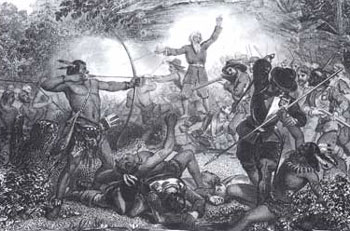Early on in the colonial times, the white men had a strong relationship with the Indians. They traded with each other and the white men brought the Indians goods and food. The colonists taught the Natives about Christianity and preached to them from the Bible. They didn't do this to take away the Natives' way of life, but they strongly believed it was the right thing to do to help the Indian people achieve salvation. Reverend John Eliot even spent many years of his life working to translate the Bible into their language. The whites depended on the Indians for survival and the Indians depended on the whites for trade. They seemed to live together happily for a period of time (http://www.militaryhistoryonline.com/horsemusket/kingphilip/default.aspx).

 The conflicted lasted two years and was one of the worst wars seen in America. One in ten soldiers on both sides were either wounded or killed and entire families were destroyed. It took decades for both sides to rebuild the progress that had been made in earlier years. Despite all of the destruction, there is one positive effect the war had on America. Because England did not give much military support to the colonists, the war was the beginning of America's independent militia. Towns organized their own militias to fight the Indians which could be thought of as the beginning of the Colonial militias that helped fight for independence from England in the Revolutionary War (http://www.militaryhistoryonline.com/horsemusket/kingphilip/default.aspx).
The conflicted lasted two years and was one of the worst wars seen in America. One in ten soldiers on both sides were either wounded or killed and entire families were destroyed. It took decades for both sides to rebuild the progress that had been made in earlier years. Despite all of the destruction, there is one positive effect the war had on America. Because England did not give much military support to the colonists, the war was the beginning of America's independent militia. Towns organized their own militias to fight the Indians which could be thought of as the beginning of the Colonial militias that helped fight for independence from England in the Revolutionary War (http://www.militaryhistoryonline.com/horsemusket/kingphilip/default.aspx).
Massasoit was the leader of the Wampanoags and he signed a treaty with the Pilgrims at Plymouth. The peace endured for fifty years but with the death of Massasoit came hostility. Massasoit's son, Philip, despised the white men. The Indians were losing trust because the whites were treating them unfairly in trades. Livestock were trampling the farming lands of the Indians and they felt threatened. One of the first major events that sparked King Philip's War was the death of his brother. Wamsutta, King Philip's brother, was taken at gunpoint into Plymouth for questioning but had fallen sick and died before he could return to his village. This infuriated Philip, but the peace was still kept. The colonists knew the Indians were no longer as satisfied with the white men as they had been in the past before the death of Wamsutta. The colonists feared an attack. In 1671, Philip was ordered to surrender all of his weapons and he did (http://www.usahistory.info/NewEngland/King-Philips-War.html).

In 1675, a Christian Indian was murdered by other Indians. His name was John Sassamon. Sassamon was a preacher for the other Indians and an informer for the colonists. He was most likely killed because of his religion and because Philip's tribe feared the loss of its culture. The suspects of the murder were taken to Plymouth and executed. As soon as the Wampanoags heard the news, they were preparing for war and the attack on Swansea took place soon after (http://www.pilgrimhall.org/philipwar.htm).
 The conflicted lasted two years and was one of the worst wars seen in America. One in ten soldiers on both sides were either wounded or killed and entire families were destroyed. It took decades for both sides to rebuild the progress that had been made in earlier years. Despite all of the destruction, there is one positive effect the war had on America. Because England did not give much military support to the colonists, the war was the beginning of America's independent militia. Towns organized their own militias to fight the Indians which could be thought of as the beginning of the Colonial militias that helped fight for independence from England in the Revolutionary War (http://www.militaryhistoryonline.com/horsemusket/kingphilip/default.aspx).
The conflicted lasted two years and was one of the worst wars seen in America. One in ten soldiers on both sides were either wounded or killed and entire families were destroyed. It took decades for both sides to rebuild the progress that had been made in earlier years. Despite all of the destruction, there is one positive effect the war had on America. Because England did not give much military support to the colonists, the war was the beginning of America's independent militia. Towns organized their own militias to fight the Indians which could be thought of as the beginning of the Colonial militias that helped fight for independence from England in the Revolutionary War (http://www.militaryhistoryonline.com/horsemusket/kingphilip/default.aspx).
No comments:
Post a Comment